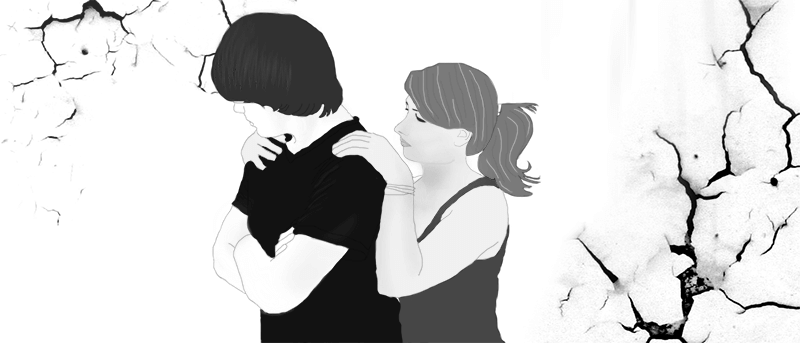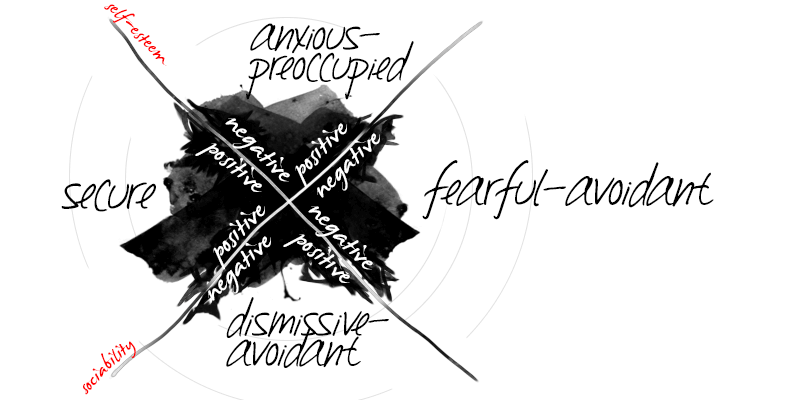Attachment Styles and How They Affect Your Relationships
If you’ve ever putzed around the internet, looking for why your relationships might all be screwed up (and screwed up in the same ways, I might add), then you’ve probably come across Attachment Theory.
Attachment Theory is an area of psychology that describes the nature of emotional attachment between humans. It begins as children with our attachment to our parents. The nature of this attachment, and how well it’s fostered and cared for, will then influence the nature of our attachment to romantic partners later in our life.1
Attachment theory began in the 1950s and has since amassed a small mountain of research behind it. Two researchers, John Bowlby and Mary Ainsworth, found that the nature in which infants get their needs met by their parents significantly contributes to their “attachment strategy” throughout their lives.2
Your attachment style doesn’t explain everything about your relationships, but it probably explains a great deal of why your close relationships have succeeded/failed in the manner they did, why you’re attracted to the people you are attracted to, and the nature of the relationship problems that come up again and again for you.
Table of Contents
The Four Styles of Attachment
According to psychologists, there are four attachment strategies adults can adopt: secure, anxious, avoidant, and anxious-avoidant.3
Secure Attachment Style
People with secure attachment strategies are comfortable displaying interest and affection. They are also comfortable being alone and independent, and display a healthy level of self-confidence. They’re able to correctly prioritize their relationships within their life and tend to draw clear boundaries and stick to them.
Secure attachment types obviously make the best romantic partners, family members, and even friends. They’re capable of accepting rejection and moving on despite the pain, but are also capable of being loyal and sacrificing when necessary. They have little issue trusting people they’re close to and are trustworthy themselves.
Secure types comfortably form intimate relationships not only with partners, but also with friends. They have no trouble revealing themselves to and occasionally relying on others when the situation calls for it. And they are excellent caregivers.4
According to research, over 50% of the population are secure attachment types.5
Meet Secure Sarah
- I find it easy to get emotionally close to my partner.
- When I show my feelings for my partner, I know that they feel the same about me.
- I know that my partner will be there when I need them.
- I want to have my partner with me when I am upset.
- I don’t worry about my partner leaving me.
Anxious Attachment Style

Anxious attachment types are often nervous and stressed about their relationships. They need constant reassurance and affection from their partner. They have trouble being alone or single. They’ll often succumb to unhealthy or abusive relationships.
Anxious types have trouble trusting people, even if they’re close to them, yet excessively rely on others for their emotional needs and to resolve their problems. Their behavior can be irrational, sporadic, and overly-emotional. They’re the ones complaining that everyone of the opposite sex are cold and heartless. And probably bursting into tears while doing so.
This is the girl who calls you 36 times in one night wondering why you didn’t call her back—let’s call her Anna. Or the guy who follows his girlfriend to work to make sure she’s not flirting with any other men.
Women are more likely to be anxious types than men,6 but it’s okay, there’s still plenty of insecurity to go around.
Meet Anxious Anna
- My partner is reluctant to get as emotionally close as I would like.
- When I tell my partner my troubles, I feel like they don’t really care.
- I find it hard to forgive my partner when they let me down.
- I often worry that my partner doesn’t love me.
- I fear that our relationship will end.
Avoidant Attachment Style
Avoidant attachment types are extremely independent, self-directed, and often uncomfortable with intimacy. They’re commitment-phobes and experts at rationalizing their way out of any intimate situation. They regularly complain about feeling “crowded” or “suffocated” when people try to get close to them. They are often paranoid that others want to control them or box them in.

In every relationship, they always have an exit strategy. Always. Avoidants often construct their lifestyle in such a way to avoid commitment or too much intimate contact.
In surveys, avoidant types score uniquely high on self-confidence and uniquely low on emotional expressiveness and warmth. They not only reveal themselves far less to their partner and friends, but also tend not to rely on others, even when they should. They score lower than other types as caregivers, meaning they’re not to be relied upon when in a pickle.7
It’s a sad fact that relationships tend to be controlled by those who care least. Therefore, avoidants tend to be the ones in control in both friendships and romantic relationships, as they are almost always willing to leave. This is opposed to anxious types, who let themselves be controlled in both.8
This is the guy—we’ll call him Alex—who works 80 hours a week and gets annoyed when women he dates want to see him more than once on the weekend. Or the girl who dates dozens of guys over the course of years but tells them all she doesn’t want “anything serious” and inevitably ends up ditching them when she gets tired of them.
Men are more likely than women to be avoidant types,9 but as always, there’s plenty of neuroses to go around.
Meet Avoidant Alex
- I prefer to keep to myself when I’m around my partner.
- I don’t talk to my partner about my feelings.
- I don’t give my partner the chance to let me down.
- I don’t want to be around my partner if I’m feeling upset.
- I wouldn’t care if my partner left me.
Anxious-Avoidant Attachment Style
Anxious-avoidant attachment types (also known as the “fearful or disorganized type”) bring together the worst of both worlds. Anxious-avoidants are not only afraid of intimacy and commitment, but they distrust and lash out emotionally at anyone who tries to get close to them. Anxious-avoidants often spend much of their time alone and miserable, or in abusive or dysfunctional relationships.
Anxious-avoidants are low in confidence and less likely to express emotions, preferring to suppress them.10 However, they can have intense emotional outbursts when under stress.11 They also don’t tend to seek help when in need due to a distrust of others. This sucks because they are also incapable of sorting through their own issues.12
Anxious-avoidants really get the worst of both worlds. They avoid intimacy not because they prefer to be alone like avoidants. Rather, they avoid intimacy because they are so terrified of its potential to hurt them.13
According to studies, only a small percentage of the population qualifies as anxious-avoidant types, and they typically have a multitude of other emotional problems in other areas of their life (i.e., substance abuse, depression, etc.14).
Meet Anxious-avoidant Aaron
- I want to get emotionally close to my partner, but I worry about them hurting my feelings.
- I want to feel close to my partner, but I also don’t trust them to want to be close to me.
- I can’t live without my partner, even though being with them isn’t working.
As with most psychological profiling, these types aren’t monolithic qualities, but scalar in nature and somewhat independent.
For instance, according to the book Attached by Amir Levie and Rachel Heller, I scored about 75% on the secure scale, 90% on the avoidant scale, and 10% on the anxious scale. And my guess is that 3-5 years ago, the secure would have been lower and the anxious would have been higher, although my avoidant has always been solidly maxed out (as any of my ex-girlfriends will tell you).
The point is, you can exhibit tendencies of more than one strategy depending on the situation and at different frequencies. Although, everyone has one dominant strategy. So Secure Sarah will still exhibit some avoidant or anxious behaviors, Anxious Anna and Avoidant Alex will sometimes exhibit secure behaviors, etc. It’s not all or nothing. But Anxious-avoidant Aaron will score high on both anxious and avoidant types and low on the secure scale.
Unf*ck Your Relationships
Your information is protected and I never spam, ever. You can view my privacy policy here.

How Attachment Styles Are Formed
Like I said previously, our attachment styles as adults are influenced by how we related to our parents (or one parent/primary caregiver) as young children. As helpless little babies, this is our first and most important relationship of our lives, so it naturally sets the “blueprint” for how we perceive all relationships as we mature.15
We use this relationship blueprint as we age into late childhood and adolescence, when we typically start to form important relationships outside of our immediate relationship with our parent(s). Our peer group takes on a larger role in our lives as we continue to learn how to relate to others. These experiences further influence our attachment style as we eventually become romantically involved with others, which, in turn, also influence our attachment style.16
So while your early experiences with your parent(s) do have a considerable influence on how you relate to others, it’s not the only factor that determines your attachment style (though it’s a big one) and your attachment style can change over time (more on this later).
Generally, though, secure attachment types regularly have their needs met as infants. They grew up feeling competent among their peers, but were also comfortable with their shortcomings to a degree. As a result, they exhibit healthy, strong boundaries as adults, can communicate their needs well in their relationships, and aren’t afraid to leave a bad one if they think they need to.
Anxious types, on the other hand, receive love and care with unpredictable sufficiency as infants. Growing up, they have positive views of their peers, but negative views of themselves. Their romantic relationships are often overly idealized and they rely too heavily on them for self-esteem. Hence the 36 calls in one night when you don’t pick up your phone.
Avoidants like Alex would have got only some of their needs met as infants, while the rest were neglected (for instance, Alex might have gotten fed regularly, but wasn’t held enough). So Alex grows up holding a negative view of others but a positive view of himself. He hasn’t depended too much on his romantic relationships for his needs and feels like he doesn’t need others for emotional support.
Anxious-avoidant Aaron, though, would have had an abusive or terribly negligent childhood. He grew up having a hard time relating to his peers. So as an adult, he seeks both intimacy and independence in romantic interactions, sometimes simultaneously, which, as you can imagine, doesn’t really go well.
Adult Attachment Styles and Relationship Configurations
Different attachment types tend to configure themselves into intimate relationships in predictable ways. Secure types are capable of dating (or handling, depending on your perspective) both anxious and avoidant types. They’re comfortable enough with themselves to give anxious types all of the reassurance they need and to give avoidant types the space they need without feeling threatened themselves.
Anxious and avoidants frequently end up in relationships with one another more often than they end up in relationships with their own types.17 That may seem counter-intuitive, but there’s order behind the madness. Avoidant types are so good at putting others off that oftentimes it’s only the anxious types who are willing to stick around and put in the extra effort to get them to open up.
For instance, Avoidant Alex may be able to successfully shirk Secure Sarah’s pushes for increased intimacy. After which, Secure Sarah will accept the rejection and move on. But Anxious Anna will only become more determined by a man who pushes her away. She’ll resort to calling him for weeks or months on end until he finally caves and commits to her. This gives Avoidant Alex the reassurance he needs that he can behave independently and Anxious Anna will wait around for him.
Often these relationships produce some degree of dysfunctional equilibrium as they fall into a pattern of chaser-chasee, which are both roles the anxious and avoidant types need in order to feel comfortable with intimacy.

Anxious-avoidants only date each other or the least secure of the anxious types or avoidant types. These relationships are very messy, if not downright abusive or negligent.
What all of this adds up to, which is the same conclusion I propose in my book, is that in relationships, insecurity finds insecurity and security finds security, even if those insecurities don’t always look the same.18 To put it bluntly, to everyone who has emailed me over the years complaining that all of the people they meet are insecure, or have trust issues, or are needy and manipulative… well, let’s just say I have some bad news for you.
What’s Your Attachment Style?
If you don’t have an idea of what your attachment style is yet and want to take a test, you can take this one. It’s a great resource that will give you an idea of your attachment style across different relationships—parents, friends, romantic partners.
I also really like it because you can track how various aspects of your attachment strategy change over time.
If you don’t want to take the test (takes maybe 10 minutes), the gist of it is this: if you’re consistently avoiding commitment, avoiding your romantic partners, shutting them out, or not sharing things with them, then you’re probably pretty avoidant.
If you’re constantly worrying about your partners, feel like they don’t like you as much as you like them, want to see them 24/7, need constant reassurance from them, then you’re probably anxious.
If you’re comfortable dating people, being intimate with them and are able to draw clear boundaries in your relationships, but also don’t mind being alone, then you’re probably secure.
Note, however, that there are some individual differences in how strongly we might identify with each attachment style. For example, you might be securely attached in most areas but have some anxious or avoidant tendencies in other situations.
That said, most people typically have a predominant attachment style they tend to fall back on in their close relationships.
Can Your Attachment Style Change?
The good news is that your attachment style can change over time—although it’s slow and difficult.
Research shows that an anxious or avoidant who enters a long-term relationship with a secure can be “raised up” to the level of the secure over an extended period of time. Unfortunately, an anxious or avoidant is also capable of “bringing down” a secure to their level of insecurity if they’re not careful.19
Also, extreme negative life events, such as divorce, death of child, serious accident, etc., can cause a secure attachment type to fall into a more insecure attachment type.20
For instance, anonymous man may be more or less secure, get married to Anxious Anna, bring her up to a more secure level, but when they run into money trouble she falls back to her anxious level, cheats on him and then divorces him for all of his money, sending him into a tailspin of avoidance. Anonymous goes on to ignore intimacy and pump-and-dump women for the next 10 years, afraid to become intimate with any of them.
If you’re beginning to think that anxious and/or avoidant behavior corresponds to the fake alpha syndrome and other insecure behavior I describe in men in my book, then you’re correct. Our attachment styles are intimately connected with our confidence in ourselves and others.
Psychologists Bartholomew and Horowitz have hypothesized a model showing that one’s attachment strategy corresponds to the degree of positive/negative self-image, and the positive/negative image of others.21

Secures exhibit both positive self-images and positive perceptions of others. Anxious types exhibit negative self-images, but positive perceptions of others (hence their needy behavior).
Avoidants exhibit positive self-images and negative perceptions of others (hence their arrogance and fear of commitment), and anxious-avoidants exhibit negative perceptions of just about everything and everyone (hence their inability to function in relationships).
Using this model as a roadmap, one can begin to navigate oneself to a more secure attachment type.
Anxious types can work on developing themselves, creating healthy boundaries and fostering a healthy self-image. Instead of constantly looking for “the one” who will magically solve all their problems (and then calling them 36 times in one night), they can look for things that will make them a better, healthier person both in body and mind.
One of my most common pieces of dating advice is for men to find something they’re passionate about and good at and make that a focal point of their life rather than women. Needless to say, the same goes for women as well.
Once they’re content with who they are, anxious types can then work to become more aware of their tendency to seek partners that reaffirm their negative self-image.22
Remember what I said about insecurity finding insecurity? Anxious types will do well to break out of that cycle and surround themselves with people, friends and lovers alike, who lift them up, rather than knock them down. And to deepen those relationships. The positive emotional experiences they get from healthy relationships, especially profound ones like with a spouse, will re-shape their view of the world, reduce their anxieties, and help mold them into more secure types.23
Avoidant types can work on opening themselves up to others, and enrich their relationships through sharing themselves more. Research shows that simply not avoiding relationships can help avoidants move away from their avoidant tendency.24 And similar to anxious types, avoidants should stop seeking to reaffirm their view of the world with every single person they meet—not everyone is untrustworthy or clingy.
Another one of my most common pieces of advice to people is that it’s your responsibility to find something great in everyone you meet. It’s not their responsibility to show you. Become curious. Stop being judgmental.
For the unlucky few who find themselves both anxious and avoidant, they can follow the advice for both types above. Focus on getting to know themselves, their fears and insecurities, embrace them, and learn to work with them, rather than against them. A few simple tools to help them do this are journaling and meditation. Professional therapy can also be effective.25
And of course, some of you may be reading this and thinking, “I like being alone and being able to sleep with whoever I want. I wouldn’t change a thing.” And it’s true—many people lead happy, successful lives as avoidant or anxious types. Some even have successful long-term relationships as an anxious or avoidant.
But research shows secures are consistently more happy and feel more supported,26 are less likely to become depressed,27 are healthier,28 retain more stable relationships, and become more successful29 than the other types.
And I can tell you from my personal experience, I’ve felt myself drift out of a strong avoidant (and slightly anxious) attachment type to a more secure attachment type over the past six years of working on myself in this area. And I can unequivocally say that I’m happier and more fulfilled in my relationships and with the women I date now than I ever was back then.
I wouldn’t trade it back for anything.
To hear more about attachment theories explained in audio/video, and how they impact our emotions both in and outside of relationships, head on over to my Emotions, Solved podcast—the last podcast you’ll ever need—here. (It’s free.)
- Collins, N. L., & Read, S. J. (1990). Adult attachment, working models, and relationship quality in dating couples. Journal of Personality and Social Psychology, 58(4), 644–663.↵
- Ainsworth, M. S., & Bowlby, J. (1991). An ethological approach to personality development. American Psychologist, 46(4), 333.↵
- Bartholomew, K., Kwong, M. J., & Hart, S. D. (2001). Attachment. In Handbook of personality disorders: Theory, research, and treatment (pp. 196–230). New York, NY, US: Guilford Press.↵
- See this study for how “Secures” score in an interview across 15 personality aspects. Those not mentioned here include: balance of control in romantic relationships and friendships, crying frequency, and warmth.↵
- Mickelson, K. D., Kessler, R. C., & Shaver, P. R. (1997). Adult attachment in a nationally representative sample. Journal of Personality and Social Psychology, 73(5), 1092.↵
- Ciocca, G., Zauri, S., Limoncin, E., Mollaioli, D., D’Antuono, L., Carosa, E., Nimbi, F. M., Simonelli, C., Balercia, G., Reisman, Y., & Jannini, E. A. (2019). Attachment Style, Sexual Orientation, and Biological Sex in their Relationships With Gender Role. Sexual Medicine, 8(1), 76–83.↵
- Bartholomew, K., & Horowitz, L. M. (1991). Attachment styles among young adults: A test of a four-category model. Journal of Personality and Social Psychology, 61(2), 226–244.↵
- Bartholomew, K., & Horowitz, L. M. (1991). Attachment styles among young adults: A test of a four-category model. Journal of Personality and Social Psychology, 61(2), 226–244.↵
- Ciocca, G., Zauri, S., Limoncin, E., Mollaioli, D., D’Antuono, L., Carosa, E., Nimbi, F. M., Simonelli, C., Balercia, G., Reisman, Y., & Jannini, E. A. (2019). Attachment Style, Sexual Orientation, and Biological Sex in their Relationships With Gender Role. Sexual Medicine, 8(1), 76–83.↵
- Bartholomew, K., & Horowitz, L. M. (1991). Attachment styles among young adults: A test of a four-category model. Journal of Personality and Social Psychology, 61(2), 226–244.↵
- Shaver, P. R., & Mikulincer, M. (2002). Attachment-related psychodynamics. Attachment & Human Development, 4(2), 133–161.↵
- Maunder, R., & Hunter, J. (2012). A Prototype-Based Model of Adult Attachment for Clinicians. Psychodynamic Psychiatry, 40, 549–573.↵
- Bartholomew, K., & Horowitz, L. M. (1991). Attachment styles among young adults: A test of a four-category model. Journal of Personality and Social Psychology, 61(2), 226–244.↵
- Caspers, K. M., Yucuis, R., Troutman, B., & Spinks, R. (2006). Attachment as an organizer of behavior: implications for substance abuse problems and willingness to seek treatment. Substance Abuse Treatment, Prevention, and Policy, 1(1), 32.↵
- Chris Fraley, R. (2002). Attachment Stability From Infancy to Adulthood: Meta-Analysis and Dynamic Modeling of Developmental Mechanisms. Personality and Social Psychology Review, 6(2), 123–151.↵
- Kirkpatrick, L. A., & Hazan, C. (1994). Attachment styles and close relationships: A four-year prospective study. Personal Relationships, 1(2), 123–142.↵
- Kirkpatrick, L. A., & Davis, K. E. (1994). Attachment style, gender, and relationship stability: A longitudinal analysis. Journal of Personality and Social Psychology, 66(3), 502–512.↵
- Vicary, A. M., & Fraley, R. C. (2007). Choose Your Own Adventure: Attachment Dynamics in a Simulated Relationship. Personality and Social Psychology Bulletin, 33(9), 1279–1291.↵
- Arriaga, X. B., Kumashiro, M., Simpson, J. A., & Overall, N. C. (2018). Revising Working Models Across Time: Relationship Situations That Enhance Attachment Security. Personality and Social Psychology Review, 22(1), 71–96.↵
- Davila, J., Burge, D., & Hammen, C. (1997). Why does attachment style change? Journal of Personality and Social Psychology, 73(4), 826–838.↵
- Bartholomew, K., & Horowitz, L. M. (1991). Attachment styles among young adults: a test of a four-category model. Journal of Personality and Social Psychology, 61(2), 226.↵
- Collins, N. L., & Read, S. J. (1990). Adult attachment, working models, and relationship quality in dating couples. Journal of Personality and Social Psychology, 58(4), 644–663.↵
- Epstein, S. (1980). Self-concept: A review and the proposal of an integrated theory of personality. In E. Staub (Ed.), Personality: Basic issues and current research. Englewood Cliffs, NJ: Prentice-Hall.↵
- This longitudinal study finds that avoidants who initiate new relationships during the study are less likely to remain avoidant than those who do not.↵
- Research shows that compelling emotional experiences that result from a strong professional relationship with a therapist (not a romantic one, mind you) could help change one’s existing model of the world.↵
- Ognibene, T. C., & Collins, N. L. (1998). Adult attachment styles, perceived social support and coping strategies. Journal of Social and Personal Relationships, 15(3), 323–345.↵
- Roberts, J. E., Gotlib, I. H., & Kassel, J. D. (1996). Adult attachment security and symptoms of depression: The mediating roles of dysfunctional attitudes and low self-esteem. Journal of Personality and Social Psychology, 70(2), 310–320.↵
- Feeney, J. A. (2000). Implications of attachment style for patterns of health and illness. Child: Care, Health & Development, 26(4), 277–288.↵
- Blustein, D. L., Prezioso, M. S., & Schultheiss, D. P. (1995). Attachment Theory and Career Development: Current Status and Future Directions. The Counseling Psychologist, 23(3), 416–432.↵
